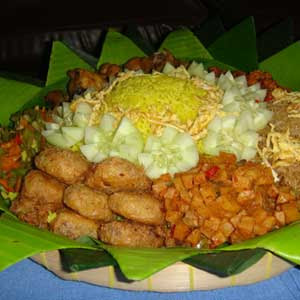|
|
|---|
Rice
Buras, rice cooked in coconut milk, served with spicy coconut powder, from Makassar.Rice is a staple for all classes in contemporary Indonesia,[6] and it holds a central part in Indonesian culture: it shapes the landscape; is sold at markets; and is served in most meals as a savoury and sweet food. Rice is most often eaten as plain rice with just a few protein and vegetable dishes as side dishes. It is also served, however, as ketupat (rice steamed in woven packets of coconut fronds), lontong (rice steamed in banana leaves), intip (rice crackers), desserts, vermicelli, noodles, arak beras (rice wine), and nasi goreng (fried rice).[7] Nasi goreng is omnipresent in Indonesia and considered as national dish [8]
Rice was only incorporated into diets, however, as either the technology to grow it or the ability to buy it from elsewhere was gained. Evidence of wild rice on the island of Sulawesi dates from 3000 BCE. Evidence for the earliest cultivation, however, comes from eighth century stone inscriptions from the central island of Java, which show kings levied taxes in rice. Divisions of labour between men, women, and animals that are still in place in Indonesian rice cultivation, can be seen carved into the ninth-century Prambanan temples in Central Java: a Water buffalo attached to a plough; women planting seedlings and pounding grain; and a man carries sheaves of rice on each end of a pole across his shoulders. In the sixteenth century, Europeans visiting the Indonesian islands saw rice as a new prestige food served to the aristocracy during ceremonies and feasts.[6]
Rice production requires exposure to the sun. Rice production in Indonesian history is linked to the development of iron tools and the domestication of Wild Asian Water Buffalo as water buffalo for cultivation of fields and manurehttp://typicalindonesiancuisine.blogspot.com/







